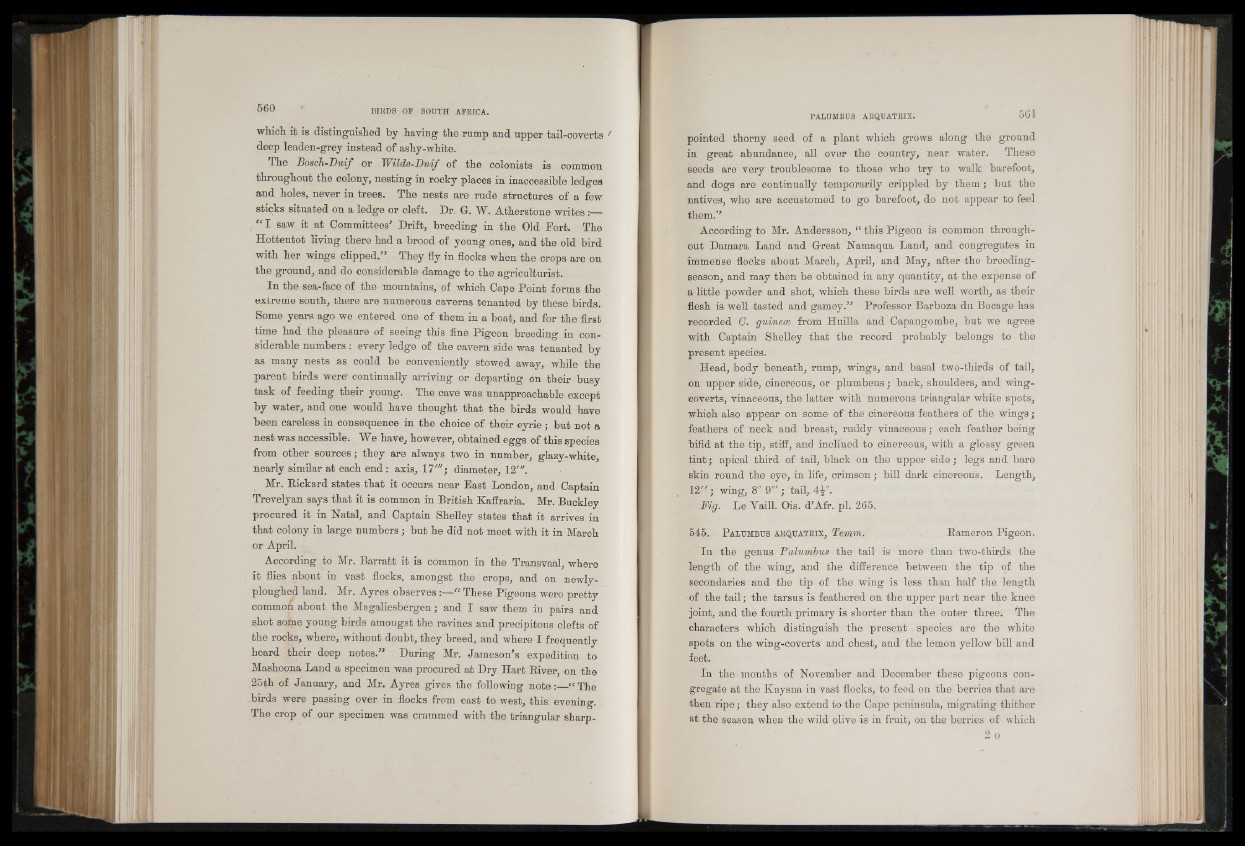
which it is distinguished by having the rump and upper tail-coverts f
deep leaden-grey instead of ashy-white.
-The Bosch-Duif or Wilde-Duif of the colonists is common
throughout the colony, nesting in rocky places in inaccessible ledges
and holes, never in trees. The nests are rude structures of a few
sticks situated on a ledge or cleft. Dr. G. W. Atherstone writes:—
“ I saw it at Committees’ Drift, breeding in the Old Fort. The
Hottentot living there had a brood of young ones, and the old bird
with her wings clipped.” They fly in flocks when the crops are on
the ground, and do considerable damage to the agriculturist.
In the sea-face of the mountains, of which Cape Point forms the
extreme south, there are numerous caverns tenanted by these birds.
Some years ago we entered one of them in a boat, and for the first
time had the pleasure of seeing this fine Pigeon breeding in considerable
numbers: every ledge of the cavern side was tenanted by
as many nests as could be conveniently stowed away, while the
parent birds werer continually arriving or departing on their busy
task of feeding their young. The cave was unapproachable except
by water, and one would have thought that the birds would have
been careless in consequence in the choice of their eyrie; but not a
nest was accessible. We have, however, obtained eggs of this species
from other sources ; they are always two m number, glazy-white,
nearly similar at each end : axis, 17"'; diameter, 12'".
Mr. Eickard states that it occurs near East London, and Captain
Trevelyan says that it is common in British Kaffraria. Mr. Buckley
procured it in Natal, and Captain Shelley states that it arrives in
that colony in large numbers ; but he did not meet with it in March
or April.
According to Mr. Barratt it is common in the Transvaal/where
it flies about m vast flocks, amongst the crops, and on newly-
ploughed land. Mr. Ayres observes :—“ These Pigeons were pretty
common about the Magaliesbergen; and I saw them in pairs and
shot sofne young birds amougst the ravines and precipitous clefts of
the rocks, where, without doubt, they breed, and where I frequently
heard their deep notes.” During Mr. Jameson’s expedition to
Mashoona Land a specimen was procured at Dry Hart Eiver, on the
25th of January, and Mr. Ayres gives the following note:—“ The
birds were passing over in flocks from east to west, this evening.
The crop of our specimen was crammed with the triangular sharppointed
thorny seed of a plant which grows along the ground
in great abundance, all over the country, near water. These
seeds are very troublesome to those who try to walk barefoot,
and dogs are continually temporarily crippled by them; but the
natives, who are accustomed to go barefoot, do not appear to feel
them.”
According to Mr. Andersson, “ this Pigeon is common throughout
Damara Land and Great Namaqua Land, and congregates in
immense flocks about March, April, and May, after the breeding-
season, and may then be obtained in any quantity, at the expense of
a little powder and shot, which these birds are well worth, as their
flesh is well tasted and gamey.” Professor Barboza du Bocage has
recorded G. guinece. from Huilla and Oapangombe, but we agree
with Captain Shelley that the record probably belongs to the
present species.
Head, body beneath, rump, wings, and basal two-thirds of tail,
on upper side, cinereous, or pluinbeus; back, shoulders, and wing-
coverts, vinaceous, the latter with numerous triangular white spots,
which also appear on some of the cinereous feathers of the wings;
feathers of neck and breast, ruddy vinaceous; each feather being
bifid at the tip, stiff, and inclined to cinereous, with a glossy green
tint; apical third of tail, black on the upper side; legs and bare
skin round the eye, in life, crimson; bill dark cinereous. Length,
12"; wing, 8" 9'"; tail,A!".
Fig. Le Yaill. Ois. d’Afr. pi. 265.
5 4 5 . P alumbus arquateix, Temm. Eameron Pigeon.
In the genus Palumbus the tail is more than two-thirds the
length of the wing, and the difference between the tip of the
secondaries and the tip of the wing is less than half the length
of the tail; the tarsus is feathered on the upper part near the knee
joint, and the fourth primary is shorter than the outer three. The
characters which distinguish the present species' are the white
spots on the wing-coverts and chest, and the lemon yellow bill and
feet.
In the months of November and December these pigeons congregate
at the Knysna in vast flocks, to feed on the berries that are
then ripe; they also extend to the Cape peninsula, migrating thither
at the season when the wild olive is in fruit, on the berries of which